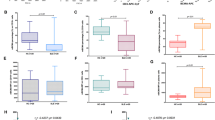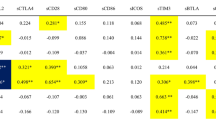Abstract
Soluble Fas (sFas) in the serum is believed to be able to inhibit apoptosis of lymphocytes. It has been reported that the serum sFas level is increased in various diseases, including malignant lymphoma and systemic lupus erythematosus. We studied the association between sFas and the prognosis of patients with aggressive non-Hodgkin’s lymphoma (NHL). Compared with normal controls, the serum sFas level was increased significantly in patients with aggressive NHL and adult T cell leukemia/lymphoma. Among patients with aggressive NHL, the complete remission rate was significantly decreased in the subgroup having high serum sFas levels. Both the overall survival rate and the disease-free survival (DFS) rate were significantly lower for this subgroup than for patients with low serum sFas levels. The 5-year survival rates estimated by the Kaplan–Meier method for patients with high and low serum sFas levels were 27.6% and 68.3%, respectively (P = 0.0001). The 5-year DFS rates estimated for patients with high and low serum sFas levels were 44.7% and 71.9%, respectively (log-rank test: P = 0.0023, and generalized Wilcoxon test: P = 0.0014). Among patients with a low and low–intermediate risk group according to the International Prognostic Index (IPI), the 5-year survival rates for low and high serum sFas subgroups were 72.8% and 42.0%, respectively, showing a significant difference (Wilcoxon test: P = 0.0163, log-rank test: P = 0.0115). Among patients with a high–intermediate and high risk group, the 5-year survival rates for low and high serum sFas subgroups were 51.6% and 17.4%, respectively, again showing a significant difference (Wilcoxon test: P = 0.0001, log-rank test: P = 0.0002). Multivariate analysis of a series of prognostic factors, including the five used to calculate the IPI, showed that the serum sFas level was an independent prognostic factor for the overall survival. Based on these results, a serum sFas level of 10 ng/ml or more can be considered to indicate a poor prognosis in patients with advanced NHL, and this finding may be useful for developing strategies for further treatment.
This is a preview of subscription content, access via your institution
Access options
Subscribe to this journal
Receive 12 print issues and online access
$259.00 per year
only $21.58 per issue
Buy this article
- Purchase on Springer Link
- Instant access to full article PDF
Prices may be subject to local taxes which are calculated during checkout
Similar content being viewed by others
Author information
Authors and Affiliations
Rights and permissions
About this article
Cite this article
Niitsu, N., Sasaki, K. & Umeda, M. A high serum soluble Fas/APO-1 level is associated with a poor outcome of aggressive non-Hodgkin’s lymphoma. Leukemia 13, 1434–1440 (1999). https://doi.org/10.1038/sj.leu.2401502
Received:
Accepted:
Published:
Issue Date:
DOI: https://doi.org/10.1038/sj.leu.2401502
Keywords
This article is cited by
-
LncRNA FAS-AS1 upregulated by its genetic variation rs6586163 promotes cell apoptosis in nasopharyngeal carcinoma through regulating mitochondria function and Fas splicing
Scientific Reports (2023)
-
FAS-antisense 1 lncRNA and production of soluble versus membrane Fas in B-cell lymphoma
Leukemia (2014)
-
Cancer and Soluble FAS
Bulletin of Experimental Biology and Medicine (2009)



